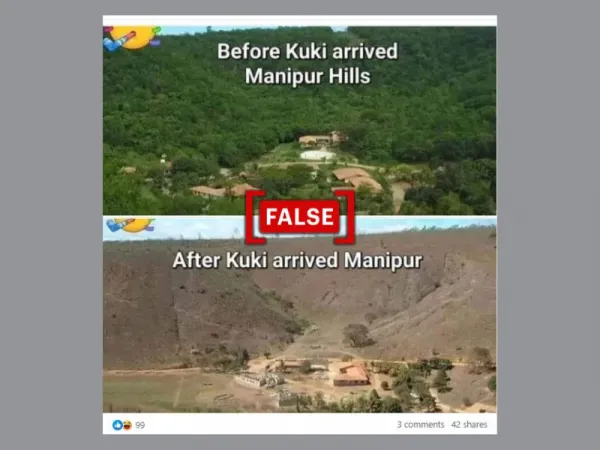By: Rahul Adhikari
February 28 2024
 Social media users have falsely linked unrelated photos from Brazil to the Manipur conflict. (Source: Facebook/Screenshot/Modified by Logically Facts)
Social media users have falsely linked unrelated photos from Brazil to the Manipur conflict. (Source: Facebook/Screenshot/Modified by Logically Facts)
The images falsely linked to Manipur actually show reforestation efforts in Brazil's Atlantic Forest by photographer Sebastião Salgado and his wife.
What is the claim?
Amid the long-standing ethnic tensions in the Indian state of Manipur, a set of two images — one depicting a seemingly barren landscape and the other green forest cover — has been circulating on social media. The text "Before Kuki arrived Manipur Hills. After Kuki arrived Manipur (sic)" is overlaid on the images, suggesting that Kukis have turned the green hills of Manipur into barren lands. An archived version of a Facebook post can be accessed here.
This claim emerges against the backdrop of prolonged ethnic violence in Manipur, which has seen conflicts between the majority Meitei community and the minority Kukis since May of the previous year, resulting in significant loss of life. The Kukis are frequently maligned as 'illegal immigrants' from Myanmar, accused of deforesting land for poppy cultivation.
Screenshot of the Facebook post sharing the viral photos. (Source: Facebook/Screenshot)
However, the photos are not from Manipur but from Brazil and depict how a plantation project has turned a barren landscape into a thriving rainforest.
What did we find?
Upon conducting a reverse image search, we identified an Instagram post by 'earthlyeducation,' dated April 8, 2023, featuring the disputed images. According to the post, these photographs depict the transformation of a barren land into a thriving forest by Brazilian photographer Sebastião Salgado and his wife, Lélia Salgado. The couple reportedly planted millions of trees over two decades as part of their Instituto Terra reforestation project. The images contrast a barren landscape in 2001 with a revitalized green land in 2019.
An Instagram post that attributes the viral photos to a reforestation project in Brazil. (Source: Instagram/earthlyeducation/screenshot)
Further scrutiny led us to a Facebook post by Instituto Terra dated January 18, 2019, comparing a similar barren landscape with lush forestation. The caption, translated from Portuguese, reads, “When it comes to Ecosystem Restoration, nature needs more than 10 years. Look what Instituto Terra has done over 18 years. Your attitude can make the difference, our challenges continue, and you can contribute through our website.”
We also found a July 31, 2015, post by Instituto Terra featuring a photo that resembles the viral image of the lush landscape.
Comparison of the viral images and Instituto Terra's Facebook photos. (Source: Facebook/Instituto Terra/Screenshot/Modified by Logically Facts)
In January 2008, Forbes published a photo story highlighting the progress of the reforestation project by Salgado’s nonprofit foundation, Instituto Terra. The article “In Pictures: Instituto Terra's Reforestation Project” features a black-and-white version of the barren landscape and an identical photo of the green landscape, including other images of the reforestation project.
The Instituto Terra, which focuses on environmental restoration and sustainable rural development in Brazil’s Rio Doce basin, was set up by Sebastião and his wife Lélia in April 1998. According to the foundation’s website, the reforestation project spans an area of nearly 700 hectares of the Atlantic Forest in the Private Reserve of Natural Heritage Bulcão Farm in Aimorés, Minas Gerais, in Southeast Brazil.
We also successfully geolocated Instituto Terra on Google Earth. A visual comparison of the viral images with the view of the foundation obtained from Google Earth confirms their location as Brazil. The viral photos show the Instituto Terra’s building and the landscape surrounding it.
Comparison of the viral photo with Google Earth imagery. (Source: Facebook/Google Earth/Screenshot/Modified by Logically Facts)
We have also contacted Instituto Terra for a comment on the images in question, and this fact-check will be updated if and when we receive a response.
Deforestation in Manipur
Deforestation in the hills of Manipur is a phenomenon that has been widely reported, with illegal poppy cultivation frequently cited as one of the primary contributors. Global Forest Watch reports that between 2002 and 2022, the area of humid primary forest in Manipur decreased by 8.5 percent.
Manipur's Chief Minister, N. Biren Singh, has claimed that immigrants from Myanmar are primarily responsible for both deforestation and the poppy cultivation in the region. The terms 'Kukis' and 'illegal immigrants' are often used interchangeably in these allegations. Nonetheless, deforestation in Manipur can be attributed to several other factors, including jhum (slash-and-burn) agriculture and the expansion of human settlements.
The verdict
The viral images show a reforestation effort in Brazil, not environmental damage in Manipur blamed on the Kuki community — a claim some social media users have inaccurately shared. Therefore, we have marked this claim as false.